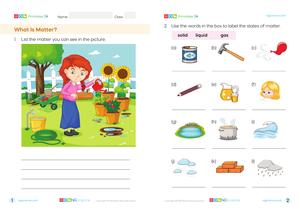Begin with a discussion on how everything around us is made of matter. Use examples from daily life like water, air, and objects in the classroom to illustrate the concept.
Go to the LessonLearning Objectives
- Understand that matter is anything that has mass and occupies space.
- Identify examples of matter in everyday life.
- Compare the mass of different objects using a balance.
- Describe volume as the amount of space matter occupies.
- Differentiate between objects based on their mass and volume.
Introduction and Hook
Direct Instruction
Explain the definition of matter as anything that has mass and occupies space. Use a balance to demonstrate how mass can be compared between different objects.
Guided Exploration
Engage students in exploring different objects to identify which are matter based on their mass and volume. Discuss how volume is the space matter occupies.
Hands-On Activity
Have students use a balance to compare the mass of various classroom objects. Encourage them to predict which objects will have greater mass and verify their predictions.
Independent Practice
Assign students to find examples of matter at home and describe their mass and volume. Encourage them to use household items to practice measuring mass with a simple balance.
Check for Understanding
Conduct a class discussion to review key concepts of matter, mass, and volume. Ask students to share their observations and findings from the hands-on activity.
Use the quiz to assess students' understanding of the properties of matter and their ability to differentiate between mass and volume.
Try the QuizReview and Reflection
Have students reflect on what they learned about matter and its properties. Encourage them to think about how understanding matter helps them in everyday life.





